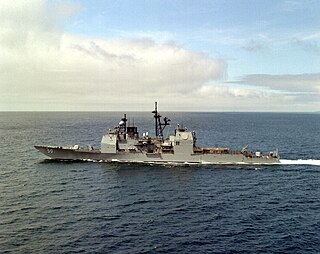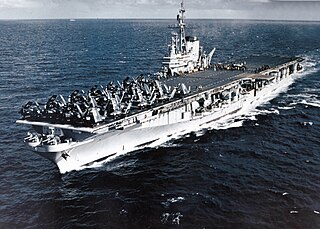USS Valley Forge may refer to:
- USS Valley Forge (CV-37) was an Essex-class aircraft carrier, later renamed USS Princeton
- USS Valley Forge (CV-45) was an Essex-class aircraft carrier, commissioned in 1946, converted to an amphibious assault ship (LPH-8) and decommissioned in 1970
- USS Valley Forge (CG-50) was a Ticonderoga-class guided missile cruiser commissioned in 1986 and decommissioned in 2004

The Essex class was a class of aircraft carriers of the United States Navy that constituted the 20th century's most numerous class of capital ships. The class consisted of 24 vessels, which came in "short-hull" and "long-hull" versions. Thirty-two ships were originally ordered, but as World War II wound down, six were canceled before construction, and two were canceled after construction had begun. No Essex-class ships were lost to enemy action, despite several vessels sustaining very heavy damage. The Essex-class carriers were the backbone of the U.S. Navy's combat strength during World War II from mid-1943 on, and, along with the addition of the three Midway-class carriers just after the war, continued to be the heart of U.S. naval strength until the supercarriers began to come into the fleet in numbers during the 1960s and 1970s.

USS Valley Forge was one of 24 Essex-class aircraft carriers built during and shortly after World War II for the United States Navy. The ship was the first US Navy ship to bear the name, and was named after Valley Forge, the 1777–1778 winter encampment of General George Washington's Continental Army. Valley Forge was commissioned in November 1946, too late to serve in World War II, but saw extensive service in the Korean War and the Vietnam War. She was reclassified in the early 1950s as an attack carrier (CVA), then to an antisubmarine carrier (CVS), and finally to an amphibious assault ship (LPH), carrying helicopters and Marines. As a CVS she served in the Atlantic and Caribbean. She was the prime recovery vessel for an early unmanned Mercury space mission. After conversion to an LPH she served extensively in the Vietnam War. Valley Forge was awarded eight battle stars for Korean War service and nine for Vietnam War service, as well as three Navy Unit Commendations.

USS Valley Forge (CG-50) was a Ticonderoga-class cruiser in the United States Navy. She was named for Valley Forge, where the Continental Army camped during one winter in the American Revolution.
| This article includes a list of ships with the same or similar names. If an internal link for a specific ship led you here, you may wish to change the link to point directly to the intended ship article, if one exists. |







